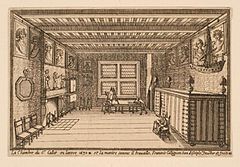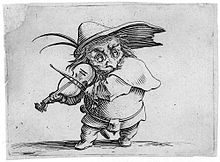Jacques Callot
Jacques Callot [ kaloː ] (* 1592 in Nancy ; † March 1635 ibid) was a Lorraine draftsman , engraver and etcher .
Life
youth
Jacques Callot was born in Nancy between March 25 and August 21, 1592. Art literary figures of his time report that he had dreamed of being an artist in Rome since early childhood and therefore ran away twice from home. The only thing that is historically guaranteed is that he began his artistic career as a goldsmith with Demenge Croq on January 16, 1607 in Nancy. Only a year later, however, he traveled to Rome, where he was apprenticed to the copper engraver Philippe Thomassin , who came from Champagne , as his biographers André Félibien and Filippo Baldinucci reported at the end of the 17th century. However, there are hardly any other sources about his life from this time and so his time in Rome remains largely in the dark. His stay in Florence is better documented.
Florence
In Antonio Tempesta's workshop , he quickly made a name for himself as an eraser. In addition to his master, he was able to produce a few sheets to illustrate the mourning ceremony of Margaret of Austria , the regent of Spain, who had recently died. These works by Callot, which are firmly dated by the book, secure his presence in Florence for 1612, even before the written documents of 1614. In 1614 at the latest he was employed in the workshop of the artist and festival manager Giulio Parigi , who worked for the Medici , as Confirm payments to Callot from an account book of the Florentine noble family. Now a long and artistically as well as financially fruitful activity began for Cosimo II. De 'Medici . The theater and the festivals in Florence and at the Medici court, which he reproduced with great accuracy - an essential characteristic of his later works in Nancy - became his profession. Here he tested his newly acquired artistic skills and brought them to perfection. In addition to pageants and types from the Commedia dell'arte , he also put a colorful mix of beggars, courtiers and cripples on paper. Above all, various landscape and figure studies testify to his development, of which the series he called " Capricci " is probably the best known. Last but not least, his Impruneta fair , which he dedicated to his patron. With the death of Cosimo II in 1621 Callot's time in Florence also ended.
Nancy

By August 1621 at the latest, Callot was living in Nancy again. Two letters that he sent to Florentine city officials from there date from this time. Artistically, the first few years in the capital of Lorraine did not produce anything particularly new. He made both the Impruneta fair and the series of Capricci again in almost unchanged form. He was also not doing well financially. In May 1623 the Lorraine Duke Heinrich II of Lorraine had to support him with goods. Soon afterwards he was able to establish himself at the court in Nancy. He made portraits of Lorraine aristocrats, including a portrait of the Lorraine court painter Claude Deruet , who was raised to the nobility in 1621 , documented the festivities at court and kept his eye for the entirety of world theater in his series of beggars and gypsies. In the late 1620s he visited Paris and the Netherlands and received commissions from the courts of France, Spain and Lorraine. In 1633 - inspired by his experiences during the invasion of Lorraine by Cardinal Richelieu's troops in the Thirty Years' War - he produced a series of 18 etchings entitled Les misères de la guerre (The Abominations of War).
Jacques Callot died in Nancy in March 1635 at the age of 43. He was buried in the church of St-François-des-Cordeliers .
plant
Callot's prints were popular and sought after across Europe; Rembrandt van Rijn - himself a master of etching - was a knowledgeable collector of his works. One of the reasons for this was its excellent technique; this was supported by some innovations he introduced. This includes the “Échoppe” (French for booth, kiosk, etc.) with an oval end and sharp edge, which can be used to create lines that swell up and down, comparable to a calligraphy pen that delivers various line widths. He also developed the repeated stopping of the etching process to a mastery; it allows extremely differentiated light-dark gradations. Finally, he is credited with a recipe for an improved masking varnish that made clearer prints possible. The majority of his plates were comparatively small. They are characterized by a sophisticated perspective and masterful lighting and became a model for generations of graphic designers in the following years.

His series Les petites misères de la guerre and Les grandes misères de la guerre , which depict the atrocities of the Thirty Years' War , were best known . Callot not only showed the simple population as victims, but also the perpetrators: the soldiers who were later imprisoned or lynched or ended up as crippled beggars. People were hanged on the gallows tree (L'arbre aux pendus - the tree with hanged people) (see picture) - soldiers and civilians who, viewed as parasites, only survive through “dishonest manners” such as looting, stealing and sometimes forced begging could. This devastating fixation of human folly and cruelty became - nearly two centuries later - the model for Francisco de Goya's famous series Los desastres de la Guerra - The Horrors of War . Callot also achieved exemplary in his landscape drawings (also in aquatint ) and his quickly thrown figure studies in chalk .
The poet ETA Hoffmann saw Callot's leaves in Bamberg at the beginning of 1813 and believed that he felt a deep kinship in his fantastic realism, which inspired him to write an essay about the graphic artist. He gave his Fantasy Pieces (1814–15), a collection of essays, stories and fairy tales, the subtitle “ In Callot's manner ” and prefaced it with the homage of Jacques Callot as an introduction. In 1820 Hoffmann received the Balli di Sfessania Callots from Serapion's brother David Ferdinand Koreff . The poet developed his story Princess Brambilla on the basis of eight etchings from this series of images .
literature
(mostly French and English)
- Esther Averill: Eyes on the World: The Story of Jacques Callot . Funk & Wagnalls, New York 1969
- Edwin DeTurck Bechtel: Jacques Callot . George Braziller Publisher, New York 1955
- Peter Bell / Dirk Suckow: Orderly disorder and family in series. Jacques Callot's Les Bohémiens cycle . In: Working group “Representations” (ed.): The other family. Critical representation analyzes from the early modern period to the present. Frankfurt a. M. [u. a.] 2013, pp. 81–116.
- Ann Brothers: Worlds in Miniature: The Etchings of Jacques Callot and Wencheslaus Hollar . National Gallery of Victory, Sydney 1998.
- Jacques Callot. The entire work in two volumes . Rogner & Bernhard, Munich 1971
- Antony Griffiths et al .:. Disasters of War: Callot, Goya, Dix . The South Bank Center, London 1998
- Jules Lieure: Jacques Callot . Editions de la Gazette des Beaux-Arts, Paris 1929.
- Jules Lieure: Catalog de l'oeuvre gravée de Jacques Callot . in 4 volumes; Paris, 1925.
- Pierre Marot: Peintres et graveurs lorrains du XVIIe siècle: Jacques Callot. Le pays lorrain . No. 3, 1953.
- Edouard Meaume: Recherches sur la vie et les œuvres de Callot . Nancy, 1854/1860.
- Götz J. Pfeiffer: Bild-Zeitung and Moral-Büchlein - the Thirty Years War in prints by Matthäus Merian and Abraham Hogenberg, Jacques Callot and Hans Ulrich Franck, in: The Thirty Years War in Hanau and the surrounding area, ed. from the Hanauer Geschichtsverein, Hanau, 2011, pp. 255–275.
- Georges Sadoul : Jacques Callot, miroir de son temps ( Jacques Callot, mirror of his time ). Editions Gallimard , Paris 1969 (reprinted 1990); ISBN 2-07-010625-X
- Eckhard Leuschner: The Printing Privilege in Tuscany: Florimi, the Falcinis and Callot , Print Quarterly 25, 2008, pp. 243-254.
Web links
- Jacques Callot at Google Arts & Culture
- Works by Jacques Callot at Zeno.org .
- Jacques Callot at artfacts.net
- Jacques Callot at artcyclopedia.com (English)
- Works in the Graphic Collection of the Louvre, Paris (French)
Individual evidence
- ↑ Cf. Berthold Seewald: The most famous image of the Thirty Years' War is to be reinterpreted in Die Welt , November 26, 2018 (viewed May 16, 2019) [1]
| personal data | |
|---|---|
| SURNAME | Callot, Jacques |
| BRIEF DESCRIPTION | French draftsman, graphic artist, engraver and eraser |
| DATE OF BIRTH | 1592 |
| PLACE OF BIRTH | Nancy |
| DATE OF DEATH | March 1635 |
| Place of death | Nancy |


